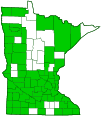prickly lettuce
(Lactuca serriola)
Conservation • Weed • Wetland • Description • Habitat • Ecology • Use • Distribution • Taxonomy
Description |
||
Prickly lettuce is an erect annual or biennial with a thick, deep taproot. The stems and leaves contain a white milky latex. The stems are unbranched except in the inflorescence. They are leafy and hairless, often with prickles near the bottom. The leaves are alternate, stalkless, blue-green, and usually lobed. The basal lobes are angular and clasp the stem. They are up to 12″ long and 4″ wide near the base, becoming smaller as they ascend the stems. They are hairless but have prickles on the leaf margin. The midvein on the underside also has prickles. The leaves are often oriented in a flat, north-south plane. The inflorescence is a long, spreading, cone-shaped, loosely-branched cluster with 13 to 27, usually 18 to 24, yellow flowers. The flower heads are about ⅜″ across and have 12 to 20 yellow ray florets. The rays have truncated tips with 5 small teeth. They dry to a bluish-white. The fruit is a pale grayish to tan achene with fluffy, white bristles attached to the tip. |
||
Height |
||
1′ to 5′ |
||
Flower Color |
||
Yellow, drying to bluish-white |
||
Similar Species |
||
Blue lettuce (Lactuca pulchella) has large, showy flower heads that measure, ¾″ across. There are no prickles on the midvein on the underside. Tall blue lettuce (Lactuca biennis) has bluish to white flowers. The achene has grayish-brown bristles attached to the tip. There are no prickles on the midvein on the underside. Woodland lettuce (Lactuca floridana var. floridana) has light blue flowers. There are no prickles on the midvein on the underside. |
||
Habitat |
||
Roadsides, disturbed sites. |
||
Ecology |
||
Flowering |
||
July to September |
||
Pests and Diseases |
||
|
||
Use |
||
|
||
Distribution |
||||
|
Sources |
|||
| 11/7/2022 | ||||
Nativity |
||||
Native to Europe, Asia, northern Africa, and the Indian subcontinent. Introduced and naturalized in North America. |
||||
Occurrence |
||||
Common |
||||
Taxonomy |
|||
| Kingdom | Plantae (Plants) | ||
| Division | Tracheophyta (Vascular Plants) | ||
| Subdivision | Spermatophytina (Seed Plants) | ||
| Class | Magnoliopsida (Dicots) | ||
Order |
Asterales (Sunflowers, Bellflowers, Fanflowers, and Allies) | ||
Family |
Asteraceae (Sunflowers, Daisies, Asters, and Allies) | ||
| Subfamily | Cichorioideae (chicories, dandelions, and allies) | ||
| Tribe | Cichorieae (lettuce, chicory, dandelion, and salsify) | ||
| Subtribe | Lactucinae | ||
| Genus | Lactuca (wild lettuces) | ||
Subordinate Taxa |
|||
|
|||
Synonyms |
|||
Lactuca scariola Lactuca virosa |
|||
Common Names |
|||
Canada wild lettuce China lettuce compass-plant horse-thistle milk-thistle prickly lettuce wild lettuce wild opium |
|||
Glossary
Achene
A dry, one-chambered, single-seeded seed capsule, formed from a single carpel, with the seed attached to the membranous outer layer (wall) only by the seed stalk; the wall, formed entirely from the wall of the superior ovary, does not split open at maturity, but relies on decay or predation to release the contents.
Clasping
Describing a leaf that wholly or partly surrounds the stem but does not fuse at the base.
Visitor Photos |
|||||
Share your photo of this plant. |
|||||
| This button not working for you? Simply email us at info@MinnesotaSeasons.com. Attach one or more photos and, if you like, a caption. |
|||||
Alfredo Colon |
|||||
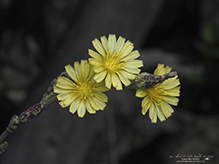 |
|||||
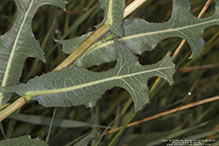 |
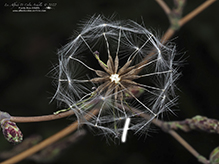 |
||||
MinnesotaSeasons.com Photos |
|||||
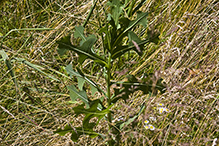 |
|||||

Slideshows |
||

Visitor Videos |
|||
Share your video of this plant. |
|||
| This button not working for you? Simply email us at info@MinnesotaSeasons.com. Attach a video, a YouTube link, or a cloud storage link. |
|||
Other Videos |
|||
| 2014 4K Lactuca serriola C0041-23 Nature Documentaries |
|||
About
Published on Jun 11, 2014 26 May 2014, Athens, GA. Lactuca serriola plant. http://en.wikipedia.org/wiki/Lactuca_serriola |
|||
| Prickly Lettuce (Lactusa Serriola) - 2012-07-28 W3stlander |
|||
About
Published on Jul 30, 2012 Prickly Lettuce (Lactuca serriola) is an annual or biennial plant, slightly foetid, that is commonly considered a weed of orchards, roadsides and field crops. The closest wild relative of cultivated lettuce (Lactuca sativa L.), it grows throughout the temperate regions of all major continents. -------------------- |
|||
| Weed of the Week #807 - Prickly Lettuce (Air Date 9/22/13) AgPhD's channel |
|||
About
Published on Oct 1, 2013 It's our Weed of the Week, Prickly Lettuce. |
|||
| Wild Edibles with Sergei & Valya Boutenko - Purple thistle or prickly lettuce RawFoodAcademy |
|||
About
Uploaded on Oct 9, 2008 http://www.RawFood.nl/ and http://www.RawFoodAcademy.com/ Two days ago Sergei Boutenko gave a wild edibles class in "het Vondelpark" in Amsterdam, Holland. Here you see the part about the purple thistle or prickly lettuce. Did you know, that you can make a green smoothie with it or eat the inside of the stem in a salad? For the complete 60 minute video, in which Sergei shows about 20 wild edibles outside in the parc, go to www.RawFoodAcademy.com. |
|||

Visitor Sightings |
|||||
Report a sighting of this plant. |
|||||
| This button not working for you? Simply email us at info@MinnesotaSeasons.com. Be sure to include a location. |
|||||
| Alfredo Colon 8/3/2022 |
Location: Albany, NY |
 |
|||
| Alfredo Colon 8/15/2019 |
Location: Woodbury, Minnesota |
 |
|||
MinnesotaSeasons.com Sightings |
|||||

|
Created: Last Updated: © MinnesotaSeasons.com. All rights reserved. |
